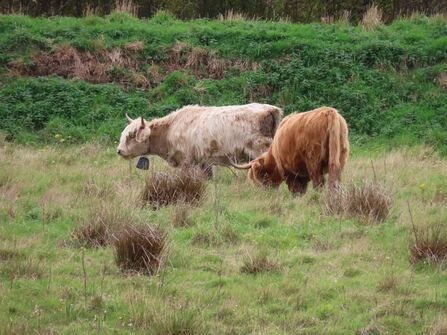
Two of the three flexigrazers at Hauxley. Image by Sheila Luck.

Two of the three flexigrazers at Hauxley. Image by Sheila Luck.
The terrific trio didn’t follow a star in the east, but rather Stephen Comber, Northumberland Wildlife Trust’s Flexigraze Co-ordinator, who guided them to the charity’s Hauxley reserve to support its meadow management programme.
As vital assets in nature recovery, the cattle - part of the Flexigraze conservation grazing herd - rotate across the wildlife charity’s reserves throughout the year, helping to create and restore grasslands and meadows.
The Hauxley three are set to graze the reserve’s wildflower meadows over winter, before moving on to pastures new at the end of January.
Unlike sheep, the cattle won’t eat the grass completely. Instead, they graze it down to a short sward over winter, allowing wildflowers to flourish in spring without obstruction. Meanwhile, the pressure from their hooves churns the soil, softening it and making it easier for birds to feed on seeds or help disperse them.
Renowned as one of the North East’s top wildlife-watching spots, the reserve bursts into colour over the summer months with wildflowers like viper’s bugloss, bloody cranesbill, and northern marsh orchid. These blooms attract a vibrant array of butterflies, including the common blue and wall brown.
Alex Lister, Northumberland Wildlife Trust Druridge Bay Landscapes Manager says:
“They say two’s company and three’s a crowd, but these three Highland cows are more than welcome at our reserve.
“Hauxley attracts over 100,000 visitors each year, many of whom come to birdwatch or simply enjoy a peaceful walk along its paths, surrounded by beautiful meadows and grasslands.
"The Flexigraze conservation grazing programme plays a vital role in maintaining these habitats, enriching the visitor experience, and supporting the diverse wildlife that calls the reserve home.”